WDGY
An invaluable source of information about the history of WDGY comes from a Masters Thesis written by Jerry Verne Haines in 1970.
1923 – 1926
DR. GEORGE YOUNG
Optometrist George W. Young started radio station KMFT in 1923; his first broadcast was on January 13, 1924, from his house at 2219 N. Bryant. The frequency was originally 1140 kc. After a couple of changes the call letters became WDGY (Dr. George Young) in 1926.
1927
In August 1927, WDGY’s transmitter was moved to Superior Blvd. and Falvey Cross Road [Wayzata Blvd. and Louisiana] in St. Louis Park. This was on the grounds of the U.S. Silver Fox Farm, at the very northern border of the Village.The document below is the application to move the transmitter in 1927.
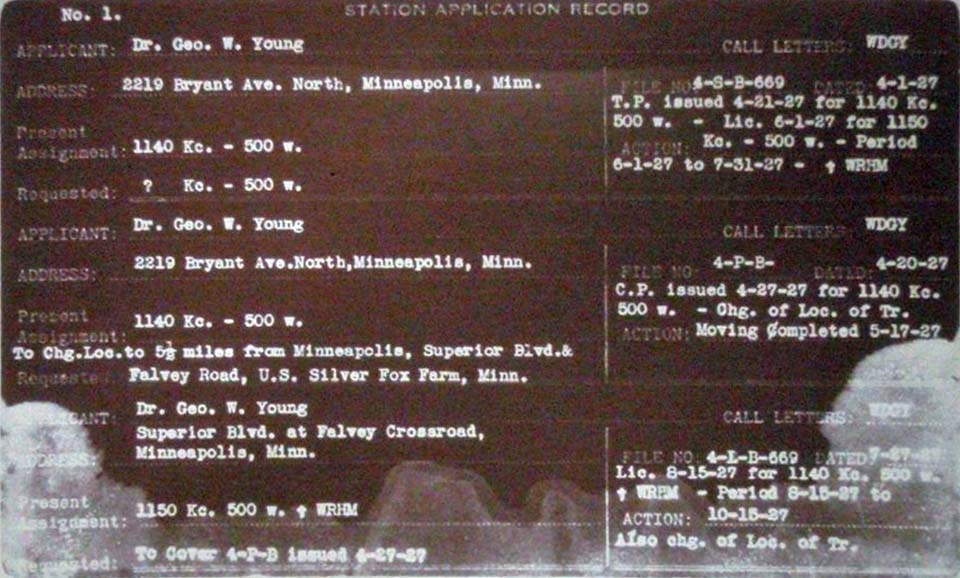
1929
In April 1929 the frequency apparently became 1180.
1933
The transmitter was destroyed by fire on February 23, 1933 and the station operated with WCCO’s old transmitter. In late 1935 a new non-directional 226 Truscan Steel Vertical Radiator (tower) was erected at the site.
1941
The station finally landed at the great 1130 on March 24, 1941, when all of the local stations were repositioned.
1945
Dr. Young died in 1945 and the station was transferred to the Twin City Broadcasting Corporation 1946. The station had a conglomeration of programs, ranging from waltzes, classical, show tunes, Tin Pan Alley, Hawaiian, religious, cowboy, and novelty.
1948
WDGY made remote broadcasts from Don Leary’s Record and Radio Store, 56 E. Hennepin (on Nicollet Island) in 1948. Bill Curtis (not Bill Kurtis of A&E) hosted “Don Leary’s Open House,” and an aircheck shows that they played a polka, country song, and jazz, and gave away an Ethel Waters record. The following photos, courtesy of the Pavek Museum of Broadcasting, show two of those appearances, although the years are unknown.
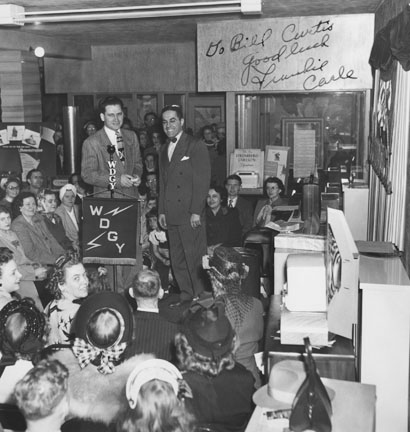
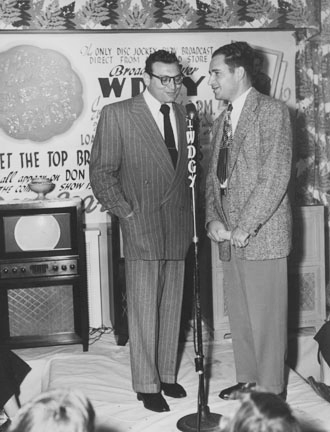
WDGY also had a “Sepia Serenade” program on Mondays and Wednesdays from 6:15-6:45 pm featuring “Negro recording stars.”
1949
An October 1949 ad in the Minneapolis Tribune called it “The Northwest Empire Station” and morning shows featured Irene and Lou, hillbilly favorites; Schuneman’s Red Rooster Hour; and Johnny Aarthun, popular singer of old-country songs.
MOVE TO BLOOMINGTON
In 1949 the station moved its transmitter and studio to a new multi-tower array described as at 102nd and Bloomington Freeway/Lyndale Freeway/35W. See the new transmitter here courtesy www.radiotapes.com
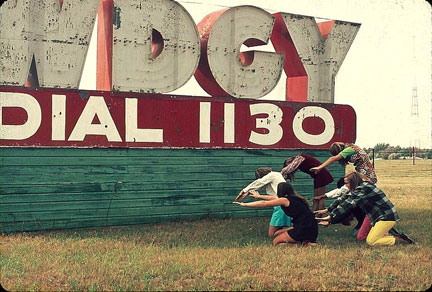
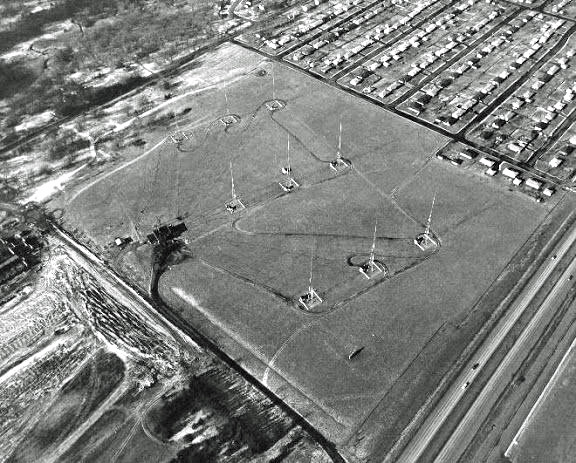
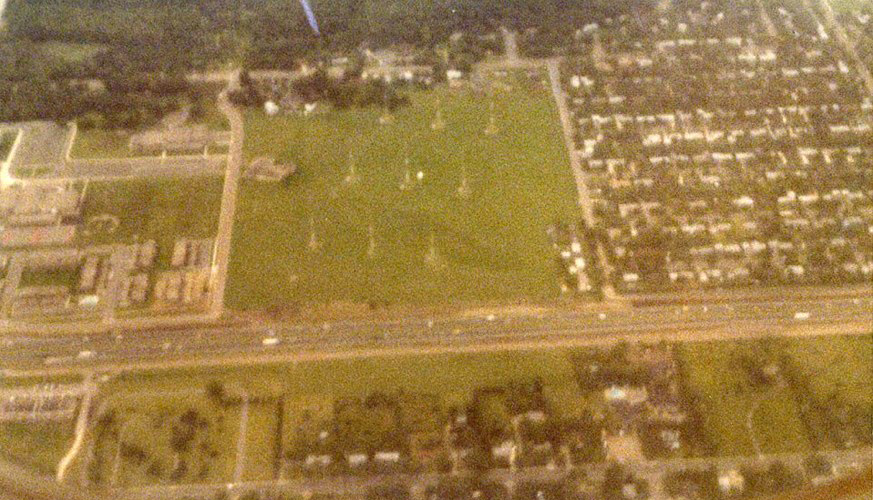
Jay says:
This is a shot of the transmitter site of WDGY/1130AM radio, along 35W at about 102nd Street. I took this from a flight I took in 1977. The 9-tower array beaming 50,000 watts was used to produce one of the most restrictive signals in the USA. To protect stations also on 1130 to the south and east, most of the power was directed north. When constructed, a Bloomington transmitter location made sense as there was little development to the south at the time. At night (with 25,000 watts) you could hardly pick up the station 5 miles to the south of the site, but the signal had an effective radiated power of 300,000 watts to the north and went right over the North Pole into the Soviet Union. It was perhaps the only American commercial radio station the Russians had to jam to prevent their people from hearing all that decadent American Rock & Roll! Today, the station is KTLK, News/Talk 1130, and uses a transmitter site in Credit River Township.
Other Facebook stories of the strength of the transmission:
- One of the obstacles it ran into was resonating re-radiation from the Bloomington Water tower. The company engineers actually had to install coils to de-tune the water tower before the license could be approved for 50kw operation.
- Matt says: “I could get them on my Lloyd’s Transistor Six … when the batteries were dead.”
- Drew Durigan: ” I dated a girl who lived on Fremont Ave. between 101st & 102nd streets. They could hear WDGY all across the AM dial, at points on the FM dial, on their CB radio base station, on their telephone, on their electronic organ, and…(drum roll please)…on their TOASTER! No audio, but the wires would vibrate in time to the modulation. Never would have believed this if I hadn’t seen it with my own eyes!”
- Drew Durigan again: ” One more testament to the sheer effective radiated power in WDGY’s nighttime lobe. Our family cabin was located north of Park Rapids. At night, WDGY was very strong, but could never be received clearly. No matter what I did, the signal was always distorted. Years later, I learned the reason why. That beam was so strong that the GROUNDWAVE signal made it at night in addition to the skywave signal. Because the two signals arrived out of phase, they cancelled each other out. That’s what caused the severe distortion, despite registering a ‘4’ on my Wards Airline signal strength scale of 1 to 5.”
- Bruce Browning: ” Supposedly, a gentleman that lived within the main lobe of the pattern had decided to wind copper around his attic and, with an appropriate capacitor, made a tuned circuit at 1130 which allowed him to power his florescent lights. It was discovered during an antenna proof, when it was noticed there was a drop in signal strength in the main lobe and it was traced to this guy’s house. ”
1951
On March 1, 1951, WDGY joined the Liberty Network, touted as the fifth major coast-to-coast network with over 300 member stations. WDGY would be the key station in the region.
Wikipedia tells us that the Liberty Broadcasting System was founded in 1948 by Gordon McLendon. At one time, it had about 500 radio station affiliates, second in size only to the Mutual Broadcasting System.
The Network mainly broadcast live recreations of major league baseball games, by following the action via Western Union ticker reports. The sound effects were very realistic, and many listeners were not aware the broadcasters were not announcing the action live. At that time some major league teams and almost all minor league baseball clubs used recreations of their road games as an economy measure.
At first McLendon only paid Major League Baseball $1,000 per year for the rights to broadcast the games, but in 1951, the leagues raised the price to $250,000 per year, and prohibited broadcasts in any city which had a minor league franchise in the Midwest. There was also a blackout on broadcast of National Football League games within a 75-mile range of league cities, which essentially ended the network. On May 16, 1952, the network ceased broadcasting.
A list of talent on the station (and it’s difficult to read) included:
- Ralph Moffat
- Raymond Gram Swing
- Laverne
- Sally Sweet
- WDGY Harvest Hands
- Hal Searls
- Uncle Lenny
- Reese Evans
- WDGY Staff Orchestra
- Jack Douglas
- Dean Sherman
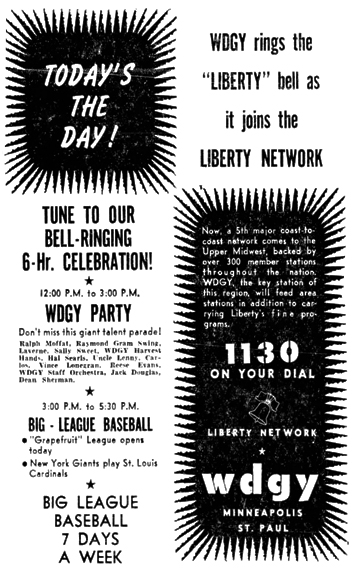
1952
TWIN CITIES BROADCASTING CO.
In 1952 the station was sold to a group of four local businessmen, one of which was Clarence T. Hagman. Hagman had previously worked for WLOL, whose owner, Ralph Atlass, had adopted the “Top Forty” format during Hagman’s time there from 1947 to 1952. When Hagman moved to WDGY, he brought the Top Forty concept with him, as well as the Mutual Broadcasting System, which aired programs like “Queen for a Day” and “Sergeant Preston of the Yukon.”
1955
A schedule from April 1955 shows Eddie Cantor and a lot of “Springtime Serenade,” but also shows just identified by the DJ (Bill Rudd and Irv Smith put in a lot of time.). That November Ty Mack put in some hours, and it was now “Autumn Serenade.” Kash Box was apparently an advertising gimmick.
1956
TODD STORZ
Todd Storz was an heir to the Storz Beer Co. out of Omaha, Nebraska. 1936 ad below courtesy Jeff Lonto.
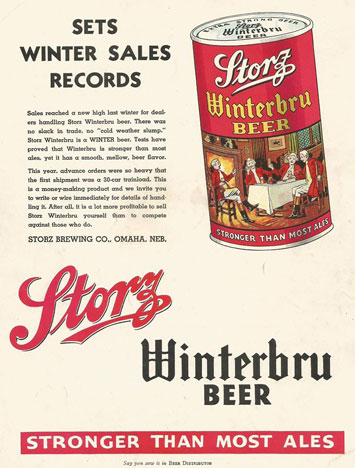
Storz’s company, Mid-Continent Broadcasting, purchased WDGY on February 6, 1956 for $212,000. It was Storz’s fourth station. The original WDGY DJs were Herb Oscar Anderson, Jack Thayer, Bill Bennett, Don Loughnane, Ralph Martin, and Len Bart. Storz also ended the affiliation with the Mutual network. (Storz died in 1964 at age 39.) Stephen B. Labunski was made General Manager. He left in July 1957 to become Vice President of ABC in New York and was replaced by Jack Thayer.
ROCK ‘N ‘ ROLL
Although we think of WDGY as the Twin Cities’ first rock ‘n’ roll station, it was not at all clear at the time. For his Master’s Thesis on the history of WDGY, Jerry Verne Haines interviewed WDGY announcer Leonard D. Bart on June 15, 1970. Haines wrote:
Rock and roll had a difficult entry into the Twin Cities market. The other stations had an unwritten agreement not to play “race music” because they assumed the Twin Cities audience would be outraged. When WDGY began to play it, WDGY salesmen found an amazing reluctance on the part of advertisers to buy time on a station that was rated number two in the market. The feeling seemed to be “we are not going to advertise on that station.”
Jim Ramsburg, an early WDGY jock, says “we were given strict orders never to utter the phrase, “Rock & Roll,” because it was black slang for sex. For that matter, we were discouraged from using the term “teenager” too. By that time Elvis had hit it big with “Heartbreak Hotel” and “Hound Dog” – a cover of a black record – followed. Covering black music was standard operating procedure in those days – Pat Boone made a fortune covering Fats Domino records. Finally, in the late 50s Sam Cooke broke the color barrier in the Midwest with “You Send Me” and black artists began to appear regularly on Top 40 charts. In summary, it was a conservative, white bread market with only a handful of stations in those days.”
TOP 40
Although many give Storz the credit for inventing the “Top 40” format, Haines asserts that it was already in place. What Storz did was apply the Top 40 concept to rock ‘n’ roll. Ramsburg says, “Let me put it this way – it was all show-biz. There’s a ton of stories circulating about Top 40 began – inspired by an Omaha tavern juke box, developed by a college statistical department, guided by BBDO’s Hit Parade formula for Lucky Strike – you name it. The fact of the matter is that 40 records plus a few extras (or extra commercials) conveniently fit into the three 55 minute periods that made up each afternoon’s Top 40 Show.” He also says that the concept of only playing 40 records was “blasphemy” in the business. He had to play the #1 song every hour, and the others at will. He’s still sick of “The Wayward Wind.”
As for where the lists came from, Ramsburg explains, “Juke box operators depended on Cash Box, which was a few weeks faster with sales figures than Billboard. Program directors like me used the more exclusive Gavin Report from Bill and Janet Gavin in San Francisco. The Gavins sold their mimeographed service to one station per market and it was kind of a co-op into which we all poured our tips. It made for a very fast, progressive Top 40 and far less corrupt than sales lists that could be influenced by cases of free product which is how payola really worked.” Even among Storz stations, Ramsburg says that each individual station made up its own Top 40. “The only coordination was (sometimes) the Pick Hit of The Week as a freebie to a record maker.”
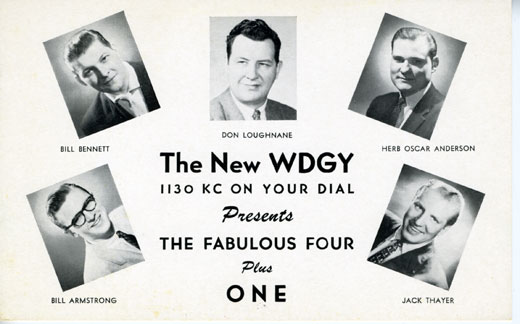
Airchecks from 1955 – ’57 on www.radiotapes.com seem to indicate that the music was pretty middle-of-the-road, but they did play “Hound Dog” on September 7, 1956 – “It’s #1!” The station was DJ-driven, with a July 2, 1956 ad touting the “Fabulous 4+1: Herb Oscar Anderson, Don Loughnane, Jack Thayer, Bill Armstrong, and Bill Bennett. At the time it was billed as “The New WDGY – Your Radioactive Station!” Top 40s available from July 21, 1956 on do show that the playlist was definitely rock ‘n’ roll, although they played a lot of cover versions and a lot of “schmaltz.” One song in ’57 looks suspiciously local: “Paddlin’ Ingabord Home” by “Ole” The Singing Janitor.
A memo to the staff from Todd Storz dated May 28, 1956, singles out the gang at WDGY for a job well done. “Minneapolis has been kind of a combination rat race and three ring circus since the “New WDGY” started, but the tremendous amount of work being done is paying off in increased ratings and business every month. In the first few months of operation, I would guess that WDGY probably lost as much money per month as any station in the history of radio. This month the losses should be fairly slight and we have every hope that June will see the station in the black for the first time in a long time. While a lot of money has gone down the drain, it looks like it has been well spent since the station is gaining solid acclaim in the Twin Cities, and some of the money should start to come back in over a period of the next few years.”
One fun item is from a Storz Stations Engineering Newsletter dated November 20, 1956. “All stations will soon be equipped with an echo chamber for ‘ON AIR’ use. A Hammond RK4 reverberation unit has been ordered… The echo unit will be .. controlled by push buttons installed at the news table and console. It is imperative that this unit be installed as soon as possible when received.”
An envelope dated October 1, 1956, is addressed to 10350 Fremont Ave. So., Minneapolis, 5, MN.
1957
In April 1957 the studio was in the Builders Exchange Building in downtown Minneapolis, and the transmitter was described as WDGY Transmitter Plant, Oxboro, Minn. It had 50,000 watts during the day and 25,000 at night.
1958
THE RADIO WONDERS
As a promotion, in November 1958 Jim Ramsburg cooked up the Radio Wonders basketball team. WDGY Jocks teamed up with professionals Ed Kalafat, Bobby Cox, Jim Springer, and Corky Devlin, possibly former Minneapolis Lakers. The team could not play high school and college teams, but would go out to small towns for exhibition games. Some not so happily as others, he admits. Proceeds would go to a charity mutually agreed upon by the two teams. The photo below, provided by Jim Ramsburg to the Pavek Museum of Broadcasting, shows Jack Thayer holding the ball. Clockwise from Jack are Bill Diehl, Don Kelly, Dan Daniel, Stanley Mack, and Ramsburg.
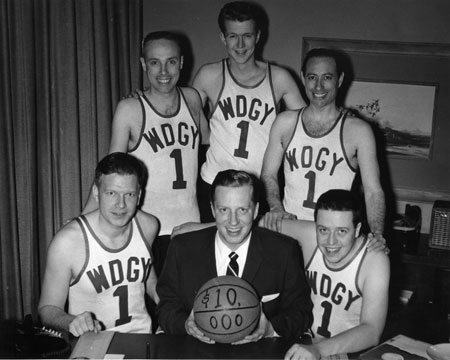
1961
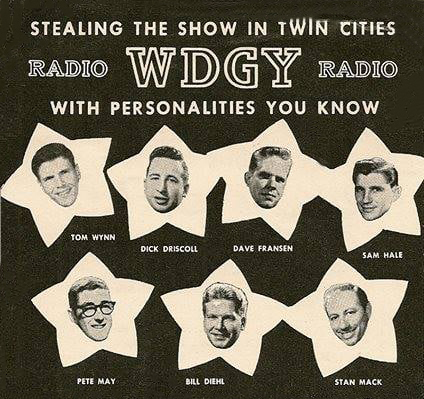
“Wonderful WeeGee,” home of the “boss jocks” like Johnny Canton, hit its stride in the ‘60s, competing neck and neck with KDWB. WeeGee tended to be a little more conservative than KDWB – reportedly even their staff wore suits and ties, but that has been disputed. Seems to be half and half in the photo below, mid-1960s.
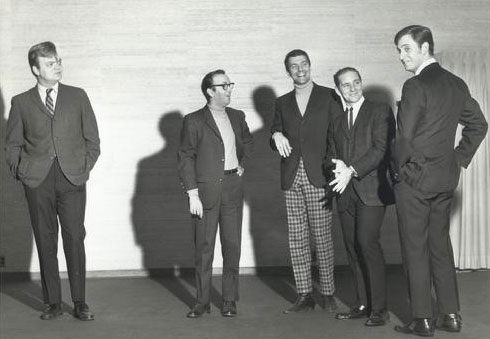
1962
In 1962 WDGY broadcast the Vikings games.
1966
See Top 30 and Top 40 countdowns from 1966 on Robb Henry’s blog.
From the “Yesterhits of Yesterday” compilation issued in 1967:
In June of 1966, WDGY began programming Much More Music for its listeners in the Twin City Area. Much More Music is simply that … WDGY played, and is playing, more music with the bright pace of the modern sound. To celebrate its first anniversary, WDGY is happy to present this album of … “YESTERHITS FROM YESTERDAY.” It includes a collection of twelve of the greatest hits from the last year. Each one of these selections was especially chosen by the WDGY All-Americans, and is performed by the original recording artists. We hope you will enjoy our first birthday edition … “YESTERHITS FROM YESTERDAY” … and join us in listening to the second year of Much More Music on 1130 Radio … WDGY.
As part of the anniversary celebration, listeners were urged to send the station a birthday card with a favorite song from the last year, and if it was drawn the listener could win the “Yesterhits” Souvenir Album and a chance of winning one of six Hondas. In 1967, winning a Honda might have meant just a motorbike.
THE PUT ON MOBILE
Somewhere there’s a story about how a station staffer would drive a dune buggy around town, and the listener who guessed closest to the number of miles driven at the end of the summer won the vehicle. I’ll tell it right when I find it again. Here’s one of the dune buggies.
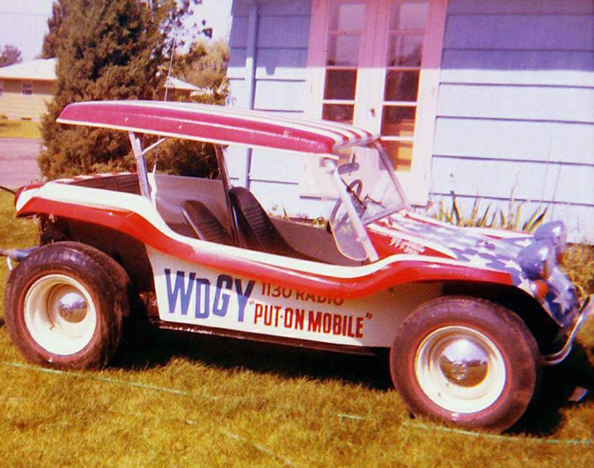
1970
From an ad from May 1970: “WDGY…A Touch of Taste.”
1972
A 1972 article in the St. Louis Park Echo opined that KDWB played new songs that were just released, while WDGY only played nationally established music.
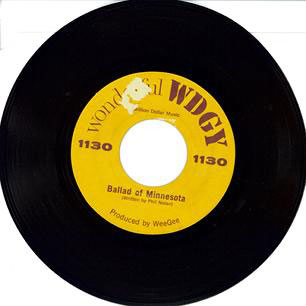
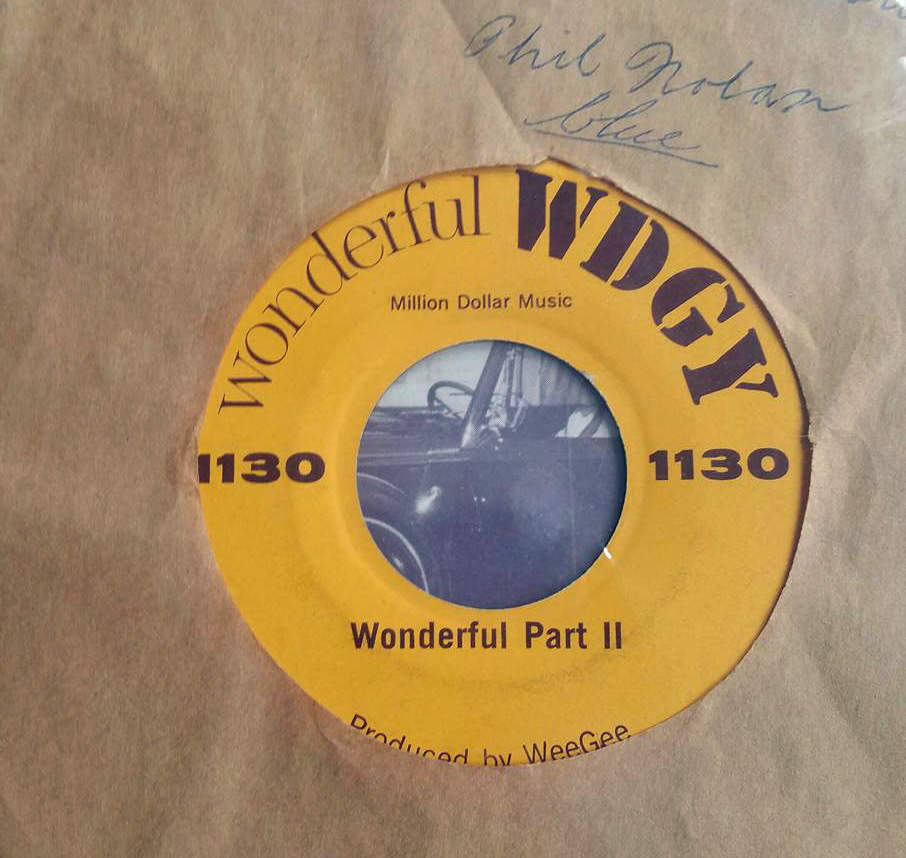
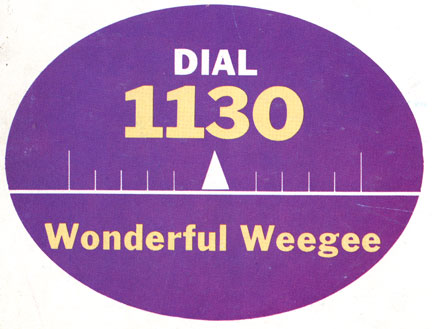
1976-1977
AOR – FOR A MOMENT: Y-11
In late 1976/early 1977, the station rebranded itself as Y-11 (never losing its WDGY call letters) and switched to a progressive rock, album-oriented format. The exact date of the change seems a little murky (unlike the very sharp change to country below), but experts say it was probably in January 1977. The music was tailored to a more mature (18-25) audience, such as Pablo Cruise.

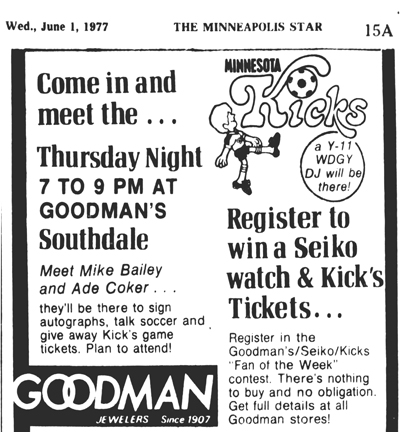
Strib.
Todd Mitchell found this article in the March 18, 1977, issue of Radio and Records, an industry newspaper.
WDGY/Minneapolis Changes to AOR
WDGY/Minneapolis has modified its Top 40 format to an AOR-slanted approach. The station will feature top cuts from current albums along with a selection of singles, with no jingle package and segued sets. According to PD Chuck Roberts, the new format “is closer to AOR than Top 40 radio. The term we are using to describe this particular form of AOR is “Coloradio.” Our research and general observations indicate that this is the direction of AM Top 40 radio, so we may as well start now.”
The switch resulted in low ratings, according to an article in the Star Tribune on September 3, 1977.
Drew Durigan’s take:
Seriously, who thought progressive rock on AM was a good idea? I’m guessing that KAAY’s “Beaker Street” was influential here. But that was overnights (considered a throwaway daypart by management) on a 50,000-watt station that reached from Canada to Cuba.
By 1977, FM radio had arrived big-time in MSP. KDWB’s listeners were gradually migrating to the FM signal. KQRS was close to adopting the SuperStars format, making them a major player. KS95 was beginning to take hold. How could this format possibly be a winner on AM?
“The Future is Now (bbzztt) The Future is Y-11”
WDGY GOES COUNTRY
At 3 pm, September 2, 1977, the station changed its format again, this time to country. The switch was preceded by a five-minute retrospective radio collage of the history of WDGY, and the first song played was John Denver’s “Thank God I’m a Country Boy.”
In a blurb in the Minneapolis Star (September 1, 1977), station manager Dale Webber was quoted as saying the reason for the change was “getting out of the ridiculous Top 40 market.” There were three other country stations on AM in the market at the time.

The photo below was posted on Facebook by Paul Strickland, who says,
Here’s a group shot of the Country WDGY airstaff from late 1978 or early 1979, taken at a Conway Twitty concert at the Minneapolis Auditorium. The most interesting thing about working there at the time was feeling the surge of relevance the station had regained on since taking on the Country format. Most Top 40 and Rock listening had migrated to the FM band (which had necessitated the Mighty 1130’s switch in the first place.) But the Country format was gaining acceptance among older baby-boomers and melding that growth with WDGY’s big 50,000-watt signal gave new purpose to the station – and validation to a growing, willing audience that perhaps Country music’s time was coming.
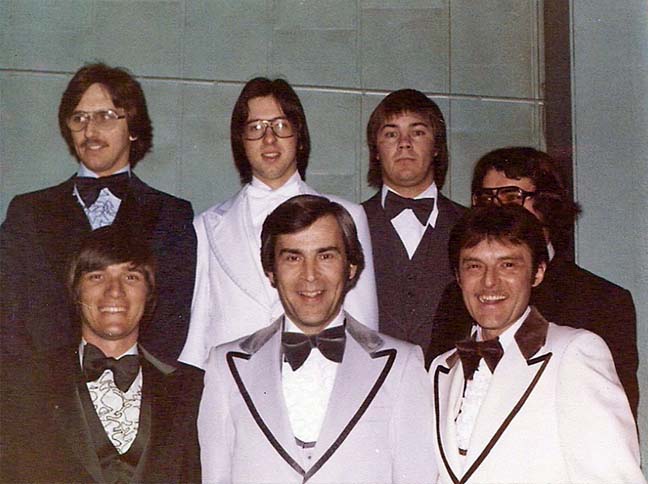
Bottom Row: Dan Halyburton, Larry E. Cummins, Jimmy Reed.
Top Row: Step Up Movie, Steve Highsmith, Gregg Lindahl, Paul Johnson.
See www.radiotapes.com/WDGY.html for airchecks and much more, including the very entertaining history of the station written by Haines.
More great stuff is on http://twincitiesradioairchecks.com/wdgy1130tapes.html
Save
Save


